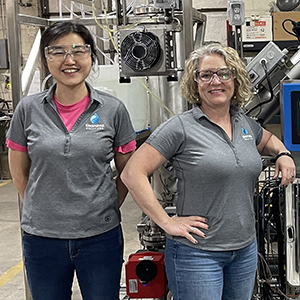Environmental pollutants known as “forever chemicals” may increase risk of type 2 diabetes in Latino girls, according to a new NIEHS-funded study by researchers from the University of Southern California (USC) Keck School of Medicine.
 Chatzi directs the USC Center for Translational Research on Environmental Health, and she leads an interdisciplinary research program focused on understanding how the environment affects chronic metabolic diseases across the life course. (Photo courtesy of Andrew Zaw / USC)
Chatzi directs the USC Center for Translational Research on Environmental Health, and she leads an interdisciplinary research program focused on understanding how the environment affects chronic metabolic diseases across the life course. (Photo courtesy of Andrew Zaw / USC)The pollutants, called per- and polyfluoroalkyl substances (PFAS), are a group of manmade chemicals used across the U.S. in a variety of industrial and consumer products, including cookware, stain repellant, and pizza boxes. The study was published Sept. 1 in the NIEHS-affiliated journal Environmental Health Perspectives.
“Because PFAS are in such widespread use and don’t break down, they have made their way into the drinking water of roughly 200 million Americans,” said senior author Lida Chatzi, M.D., Ph.D., professor of population and public health sciences at the Keck School of Medicine and director of the new USC Center for Translational Research on Environmental Health. “This is the first study to measure their potential impact on glucose metabolism over time among adolescents and young adults.”
Researchers examined more than 310 Latino children between the ages of eight and 13 from the Study of Latino Adolescents at Risk of Type 2 Diabetes. Each participant was tested for levels of certain PFAS at the start of the study and then followed up for up to 12 years, with annual checkups on how their bodies metabolized glucose. Generizability of findings was tested in young adults from the Southern California Children's Health Study who participated in a clinical visit with a similar protocol.
PFAS and glucose metabolism
Data from the study showed that starting in late puberty, girls who had high levels in childhood of a PFAS called perfluorohexane sulfonate (PFHxS) tended to have poorer glucose metabolism than girls who had low levels of PFHxS as children. The association between high levels of PFHxS and dysregulated glucose metabolism increased after puberty and persisted through 18 years of age. The researchers replicated their findings in the Southern California Children’s Health Study, showing that this link may persist into adulthood.
According to the researchers, there was no consistent association between high levels of PFAS and dysregulated glucose metabolism in boys.
 PFAS have been linked to immune dysfunction, altered metabolism, effects on brain development, and certain cancers. (Photo courtesy of Joyseulay / Shutterstock.com)
PFAS have been linked to immune dysfunction, altered metabolism, effects on brain development, and certain cancers. (Photo courtesy of Joyseulay / Shutterstock.com)“We saw the biggest changes in glucose metabolism in puberty, and there are many differences in puberty between boys and girls,” said first author Jesse Goodrich, Ph.D., a postdoctoral scholar at the Keck School of Medicine. “One hypothesis is that PFAS may interact with sex hormones. We plan to follow up on this study by examining the biological mechanism behind the association of PFAS with type 2 diabetes.”
Young Latinos at higher risk of type 2 diabetes
The rate of diabetes in Latino children in the U.S. is five times higher than that of non-Hispanic white children, and in Latino adults, the rate is 80% higher than that in non-Hispanic white adults. Yet diet and lifestyle alone don’t account for the difference.
“Type 2 diabetes is potentially preventable, and one key area of focus should be environmental influences,” said Chatzi. “PFAS exposures are modifiable through individual behaviors such as avoiding nonstick cookware and plastic containers for food storage. But we are not just exposed in one place or one source — PFAS are everywhere. Government can play a major role in regulating the use of PFAS.”
Although certain PFAS are no longer manufactured in the U.S., they are still produced internationally and can be imported into the U.S. in consumer goods such as carpet, leather and apparel, textiles, paper and packaging, coatings, rubber, and plastics, according to the U.S. Environmental Protection Agency (EPA). In July, the U.S. House of Representatives passed the PFAS Action Act, which would require the EPA to establish national drinking water standards for these substances.
Citation: Goodrich JA, Alderete TL, Baumert BO, Berhane K, Chen Z, Gilliland FD, Goran MI, Hu X, Jones DP, Margetaki K, Rock S, Stratakis N, Valvi D, Walker DI, Conti DV, Chatzi L. 2021. Exposure to perfluoroalkyl substances and glucose homeostasis in youth. Environ Health Perspect 129(9):97002.
(Original press release by Jeremy Deutchman, Keck School News)









